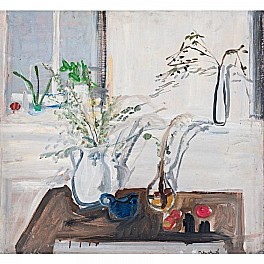BIOGRAPHY

American (1927-1995)
Anne Tabachnick was a self-described "lyrical expressionist" whose works combined elements of the European "Grand Trandition" of El Greco, Cezanne, Bonnaard and Matisse with the expressionist techniques of the New York School Abstract Expressionist painters. Her practice was concerned, in part with how to "show how a realistic painter might reclaim for herself and for others the lost sense of suddenness that is fundamental to any visual encounter. To achieve this, her paintings revive the initial disorientation of arriving upon given objects, that opacity which in ordinary time dissolves as soon as our minds have situated the objects and intellectualized their names, relations and uses." She accomplished by painting a kind of dissolved, dissapating, abstracted reality--as if time is already erasing the object we see as we see it.
Born in Connecticut in 1927, she was influenced by her father, a Yiddish poet and intellectual who had participated in the Russian revolution before he immigrated to America. She spent most of her life in New York City. Inspired by her father’s commitment to books and political ideals, she was drawn to academic study and to art making, and fell in with the burgeoning Greenwich Village bohemian scene of the 1940s. As a teenager, she modeled for Nell Blaine’s students, who included Jane Freilicher and Larry Rivers. Blaine remained an inspirational teacher and mentor to Tabachnick.
Just as she was getting started as a painter, Abstract Expressionism exploded on the New York scene. Like her slightly older colleagues who had also studied with Hofmann — Robert De Niro Sr, Al Kresch, Leland Bell and Louise Matthiasdottir — Tabachnick adopted Hofmann’s forceful coloration and buoyant abstraction while she gradually converted to a realistic mode exemplified by French figurative painter Jean Hélion. Hélion had fled the war in Europe and arrived in New York City in the 1940s, where he showed fledgling American artists like Tabachnick how they could integrate the innovations of the Cubists and Neoplasticists into a fresh kind of representational painting.
One critic describes her method thusly:
"Tabachnick retraces our experience of sight back to that fleeting pre-rational moment in which we intuitively grasp two objects — cut logs, fine china — but haven’t yet made sense of what those objects are doing in the space they inhabit. As a result of that acute uncertainty, these otherwise recognizable objects shed their customary names and functions: the pairing lingers as purely visual phenomena. Their solidity and texture — their thingness — eclipses their utility, and we see them more profoundly than we would if they were depicted in a settled context." Tabachnick is represented in the collections of the Metropolitan Museum of Art, the Museum of Modern Art and the University Art Museum, Berkeley.
Tabachnick is represented in the collections of the Metropolitan Museum of Art, the Museum of Modern Art and the University Art Museum, Berkeley.
